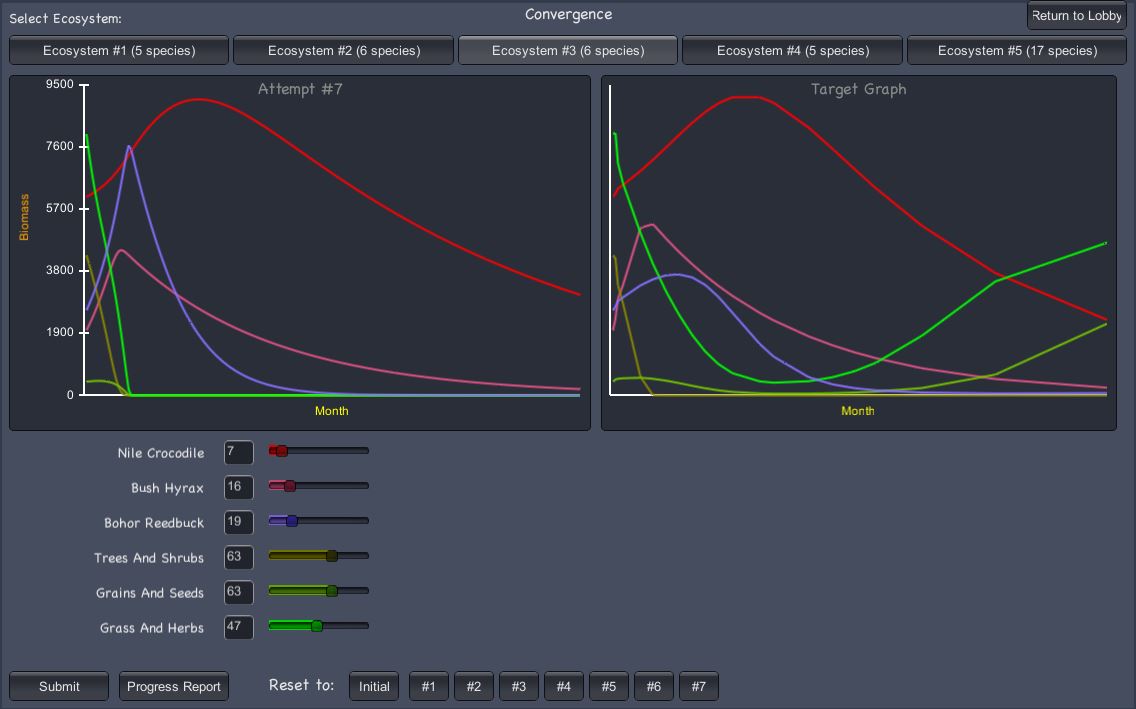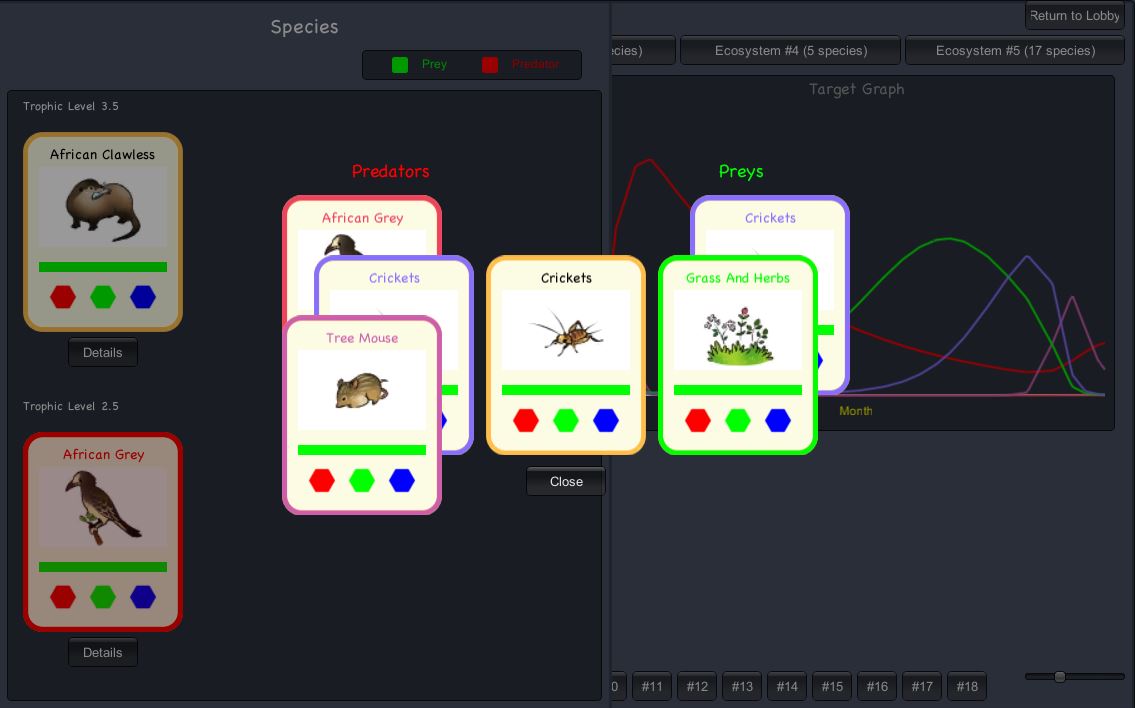Introduction
Convergence is an exciting game that allows you to control the development of an ecosystem while learning more about science.
Convergence is a single player game. You choose an ecosystem for play. You may play multiple ecosystems. The screen capture at the right shows 5 ecosystems selectable by buttons at the top. Each ecosystem lists the number of species. There are plant as well as animal species. The player can play one ecosystem for a while and then switch to another. Ecosystem #3 has been selected for play in the screen capture to the right. In Ecosystem #3 there are 6 species as shown near the lower left corner. Some are animals and some are plants. The amount of starting biomass is fixed for each specie. However, for plants the growth rate and carrying capacity (which puts a limit on potential growth) is user programmable. For animals, the metabolic rate is programmable. These items are changed by moving the slider or entering a value in the box. Both means of input accomplish the same thing.
The objective of the game is for the player to match, as closely as possible, the Target graph. In the image to the right the Target graph can be seen on the right side. This is the goal. The player has just completed Attempt #7. The red line matches reasonably well. It is for the Nile Crocodile. However, the blue line has too much of a spike in Attempt #7 as compared to the Target. The blue line is for the Bohor Reedbuck. The player's goal is to make adjustments in the growth rate / carrying capacity for the plants, and in the metabolic rate for animals to match the Target graph as closely as possible. The player makes changes to the right of the specie name in the lower left part of the screen. There are two means to make the adjustment. Both means accomplish the same thing. For a large change, the player can drag the slider. For a small change, the player can enter a number.
The player enters her changes for the attempt using the sliders and entry boxes as needed. Then, she presses the 'Submit' button in the lower left corner. This submits the simulation run and updates the display on the left based upon the impact of the entry. The simulation runs through many time steps to show how the ecosystem would develop with the specified input parameters.

Large Ecosystems provide more challenge
Complex ecosystems increse interaction
Ecosystem #5 is shown to the right. It is a much more complex ecosystem. Once the player has gain some mastery of the other ecosystems, she can try Ecosystem #5 whose many species will provide additional challenge.
Prior attempts are an important help
Prior Attempts are provided to the player to review previous attempt results. These are seen in the image to the right along the bottom. In this example, there are a total of 16 prior attempts the player has made. The player is presently considering her inputs for Attempt #17. She can press any of the butons labelled #16, #15, #14, ... to see the graph and entry settings for that attempt. This allows her to gain insights for the present attempt, or if the prior attempt was better, she can use that as a new starting point. Notice next to the phrase 'Reset to:' is a button with the text 'Initial'. This can be pressed to start over at the initial setting for that ecosystem. Also, there are too many buttons to fit, so it only goes down to #4. The slider in the lower right cover can be used to access earlier attempts.

Progress Report Chart
View Prior Attempt Scores
The game calculates a score for every attempt. It is based upon how closely the graphs line up. A smaller score means the attempt graph lines up closer to the target graph. A score of 0 means a perfect fit.
The player can view the scores of the present and past attempts by clicking the 'Progress Report' button near the lower left corner. This will display the graph shown to the right. The lower score is supperior. The Initial score is shown and the score for Attepts #24 to #28 (the last 5 attempts) are shown also. The slider can be used to see earlier attempt scores. As can be seen, the player improved on the last attempt, but Attempt #24 is the best shown.
The stack chart is color coded to show the species that are further from the goal. In this example, the green specie (Grass and Herbs) is the furthest from the goal.

View Species Interactions
Food Chain helps player understand ecosystem
The Convergence game provides the player the ability to view the food chain or species interaction for the ecosystem he is playing. This helps in choosing which parameters to change for this attempt. The predator / prey relationship for a given specie can be seen by clicking on the name of the specie in the lower left portion of the screen. This will bring up a display as shown to the right. The specie clicked upon will appear in the middle as is the case with the Crickets in this example. To the left are the predators and to the right are the prey. The 'Close' button is used to return to the game.
Conclusion
The Convergence game has been designed to be entertaining and challenging, while also teaching important scientific principles. We trust that as you are being entertained and challenged in your efforts to match the target graph, you will discover that your understanding and appreciation of our world's ecosystems has increased.

